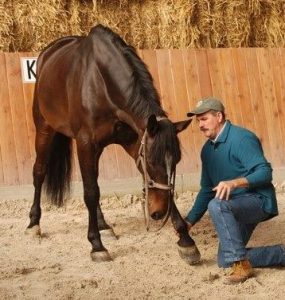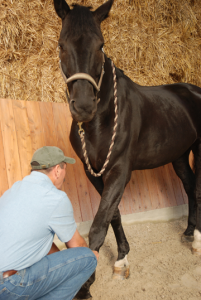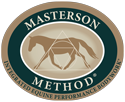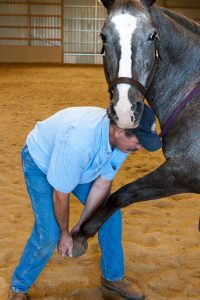Many questions come up about the Scapula Release Down and Forward Technique and how to best help the horse. To illustrate the best position to be in and where the horse is during this technique, it is helpful to see it all on one page. Here are a few of the questions often asked at courses and online.
What if my horse begins to relax the leg down, then pulls up?
As with other techniques, at some point this will happen. As you’re asking the horse to relax the leg down, in most cases he will pull up before his foot reaches the ground. This is the point of restriction that we are helping the horse to move through. But we have to help him do it in a relaxed state (for him, not us!).
The best way to do this is to have the foot by the toe so that you can,
1) Yield and go up with the leg without losing control of the leg.
2) Be in a position to support his weight when he stops pulling and he relaxes into your hand.
When you feel the horse begin to even slightly pull back or lift up on the leg, support the leg up toward the shoulder, giving him the opportunity to relax the shoulder. Once you have all the weight again, you can start to lower it again. This will allow him to relax through that point of restriction and be able to more comfortably drop the scapula. This may happen a couple of times before he is able to relax the leg down completely.
When you feel or anticipate tensing, support the leg up toward the shoulder to relax the leg, then continue down. You may have to do this a couple of times on the way down. If the leg gets heavier, or your back gets sorer, you can put the leg down and rest, and start again where you left off. Any of these techniques can be done successfully in increments.
It may also make it easier for him if you only ask him to set the foot down a short distance forward rather than a longer distance. Remember to pick a starting point straight down from the knee.
What if my horse quickly steps forward and puts all of his weight on the leg without relaxing it?

First, be sure that the horse is standing square when you first pick up the leg, that you’re not asking him to step too far, or are pulling him off balance. When picking up any leg you have to allow the horse to balance on the other three legs.
Second, you can to some degree pre-empt his falling forward by having a solid grip of the toe, stepping closer into the horse, and pushing up on the leg to keep the horse’s weight on the other three legs. Be ready to do this if this happens more than once, or if you suspect this might happen.
Do not continue to bring the foot out and let the horse hyper-extend the leg. If the horse is just too heavy, immediately set the foot down and start over again, this time asking for only a short distance forward.
Here’s a trick – As with the leg back, you can use your body to keep him on the opposite leg just a bit longer, giving him the chance to release the shoulder before putting all of his weight on it. It is a little different in this leg forward position. Stand in close to the horse, facing back, with one leg just inside of the mid-line (as shown in the photo). Lean your shoulder against the horse’s shoulder and gently ask him to shift his weight over as you ask him to pick up the leg. Without picking up the foot, slide the leg forward maybe a, well… foot (that damn pun, again) as you keep his weight on the opposite leg for a bit. This will give him a chance to relax the shoulder down in a way that is much more comfortable, especially if there is a lot of tension in this junction that he is trying to protect.
Can I ask the leg to come out to the side?
Yes. If the leg is relaxed, you can slide the toe out to the side (laterally) to release tension in this position. It’s important that you not pull or force the leg out, especially if the horse pulls back. But if he is relaxed then you can release tension in the sternum, pectorals and other muscles of the shoulder by relaxing the leg back, out to the side, and across the front. Just remember not to force the issue. They have to relax into these positions.
out, especially if the horse pulls back. But if he is relaxed then you can release tension in the sternum, pectorals and other muscles of the shoulder by relaxing the leg back, out to the side, and across the front. Just remember not to force the issue. They have to relax into these positions.
 out, especially if the horse pulls back. But if he is relaxed then you can release tension in the sternum, pectorals and other muscles of the shoulder by relaxing the leg back, out to the side, and across the front. Just remember not to force the issue. They have to relax into these positions.
out, especially if the horse pulls back. But if he is relaxed then you can release tension in the sternum, pectorals and other muscles of the shoulder by relaxing the leg back, out to the side, and across the front. Just remember not to force the issue. They have to relax into these positions.Be aware of possible discomfort or injury. It is possible that there is discomfort or injury farther up in the neck/shoulder/withers, or in the opposite leg that may make it difficult for the horse to hold the leg up, or in the position you want. If in doubt, it’s always best to err on the side of caution and keep the horse in a stable position.
What if my horse’s foot crosses over in front?
 Guide the foot down wherever is the most comfortable for the horse. Due to conformational factors or muscle tightness issues, different horses are comfortable resting their feet in different positions. The best place to start with any technique is where the horse is most comfortable, and then to help the horse gradually move out from there in a relaxed state. Crossing over the midline in front is good for the horse.
Guide the foot down wherever is the most comfortable for the horse. Due to conformational factors or muscle tightness issues, different horses are comfortable resting their feet in different positions. The best place to start with any technique is where the horse is most comfortable, and then to help the horse gradually move out from there in a relaxed state. Crossing over the midline in front is good for the horse.With any of the Masterson Method® Techniques, allow at least 20-30 seconds for him to “feel” what is going on the first time. Give him some space: Some horses need more than others to really relax. Watch his eyes for the signs of “processing” the release.
Learn all of The Masterson Method® Techniques and much more in our Beyond Horse Massage DVD and/or Online Streaming.

